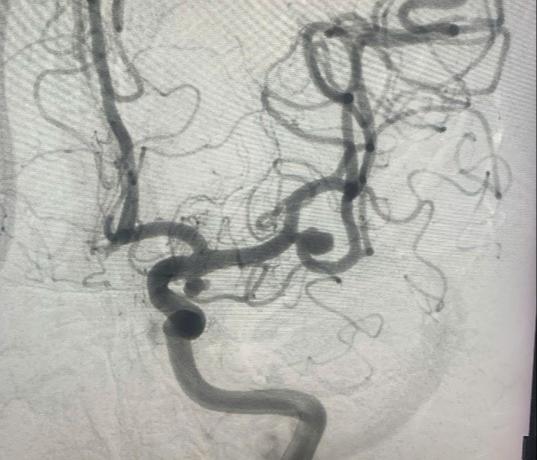GĐXH – After 2 weeks of headaches and taking medicine without relief, Mr. D went to the hospital and was diagnosed with a brain aneurysm that was at high risk of rupture.
Recently, doctors at 108 Military Central Hospital received and treated a patient with a cerebral aneurysm.
Accordingly, a 58-year-old male patient PVD (Hanoi) was admitted to the Department of Cardiovascular Diagnosis and Intervention, 108 Central Military Hospital because of a dull headache for 2 weeks, which did not improve with medication.
At the hospital, CT scan results showed that the patient had a brain aneurysm with a high risk of rupture, and was admitted for intervention.

DSA image before intervention. Photo: BVCC.
The patient underwent intervention to plug the aneurysm with a metal spring. The treatment went well, and the patient was discharged after 24 hours and returned to normal life.
Causes and symptoms of cerebral aneurysm
According to Dr. Luong Tuan Anh, Department of Cardiovascular Diagnosis and Intervention, 108 Central Military Hospital, cerebral aneurysm is a phenomenon in which a blood vessel in the brain has a larger diameter than normal, occurring when the blood vessel is weak and bulges under the pressure of blood flow.
If not detected and treated, the aneurysm will gradually increase in size, rupture, and cause subarachnoid hemorrhage (a type of brain hemorrhage).
Dr. Luong Tuan Anh said that there are many causes and risk factors for cerebral aneurysms such as congenital, smoking, obesity, etc., but the most notable is high blood pressure.
Symptoms of cerebral aneurysm are often unclear and progress silently until the aneurysm ruptures, the patient suddenly has severe headaches, vomiting and nausea. Therefore, patients need to be screened for early detection when there are signs of suspected cerebral aneurysm such as spontaneous headaches, dull headaches lasting for many days, headaches more severe than previous headaches or headaches that do not respond well to conventional medications.
Who is prone to headaches?

People who work under stress, have insomnia, or have chronic diseases such as high blood pressure, diabetes, etc. are prone to headaches. Illustrative photo.
According to doctors, some causes of headaches can include:
- Benign headaches: Vasomotor headaches, Migraine headaches, temporal arteritis, flu...
- Headaches related to infectious diseases: Encephalitis, meningitis, systemic or localized infectious fever...
- Headache related to neurological diseases: Cerebral hemorrhage, cerebral infarction, brain tumor, cerebral vascular malformation...
- Headache in some other diseases: Anemia, poisoning, endocrine diseases, anxiety disorders, stress...
People who may experience headaches include: People who work under stress, people who work a lot in front of computers, people with insomnia, people with chronic diseases such as high blood pressure or diabetes...
When should you see a doctor for a headache?
- Persistent, dull headache or severe headache.
- Headache accompanied by facial numbness, numbness or weakness in one or both arms or legs.
- Symptoms include fever, vomiting, convulsions, blurred vision, tinnitus, difficulty speaking...
Tests that can be done to find the cause of headaches include: Blood tests, CT scans, brain scanners, brain MRIs, electroencephalograms, lumbar punctures... and other necessary tests.
Source: https://giadinh.suckhoedoisong.vn/dau-dau-am-i-nguoi-dan-ong-58-tuoi-o-ha-noi-suyt-vo-mach-mau-nao-vi-can-benh-nay-172241215163620147.htm



![[Photo] General Secretary To Lam meets and expresses gratitude to Vietnam's Belarusian friends](https://vphoto.vietnam.vn/thumb/1200x675/vietnam/resource/IMAGE/2025/5/11/c515ee2054c54a87aa8a7cb520f2fa6e)

![[Photo] General Secretary To Lam concludes visit to Russia, departs for Belarus](https://vphoto.vietnam.vn/thumb/1200x675/vietnam/resource/IMAGE/2025/5/11/0acf1081a95e4b1d9886c67fdafd95ed)

![[Photo] General Secretary To Lam arrives in Minsk, begins state visit to Belarus](https://vphoto.vietnam.vn/thumb/1200x675/vietnam/resource/IMAGE/2025/5/11/76602f587468437f8b5b7104495f444d)
























![[Photo] National Assembly Chairman Tran Thanh Man attends the Party Congress of the Committee for Culture and Social Affairs](https://vphoto.vietnam.vn/thumb/1200x675/vietnam/resource/IMAGE/2025/5/11/f5ed02beb9404bca998a08b34ef255a6)































































Comment (0)